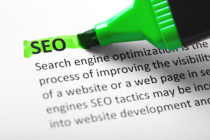We are living in an era where a new e-commerce site pops up every another day. And, these website are built keeping in mind even the minutest component. But, there’s no doubt that ranking higher than your Google competitors is a must.
SEO plays a key role in Google rankings. If a website is missing out on clicks then, there are great chances of it missing out on sales as well. SEO should run parallel with the time it started building up. Not only those who are looking forward to build their website right from the first time will agree on this but, even for the websites which require redesigning, SEO certainly proves to be a viable option to compete in the Google rankings. In order to juice up the full potential of their website, rank higher in search engines, etc., SEO is a must.
Importance of SEO in Ecommerce Site Building Process
Studies suggest that 30 per cent of the total traffic on an e-commerce site comes from organic searches. Investing in a long term SEO strategy for great ranking on Google should be focused right from the beginning. Here are some reasons to emphasize on the SEO:
- The site’s design can impact drastically on the search engine visibility when it’s altered, and will therefore affect the site’s traffic and sales.
- Good search engine rankings are not forever. At some point re-thinking in terms of SEO is bound to happen in order to maintain the position on the leaderboards.
- When there are far too many players operating in the online space, an effective SEO will always have the strength to set up ahead of others.
- SEO helps in improving user experience in ways that go far beyond just keywords and rankings. It reinforces the information architect, web development, user interface, website design and content, pointing towards the need to get better.
- A true SEO will make use of data in order to help the business understand deeper about its customers, which will definitely take the business to succeed both in terms of ranking and sales figures.
Four Critical Areas Fulfilled by Ecommerce SEO:
- Problems your clients find the most troublesome
- Solutions they are searching for
- Customer expectations with each of the offers.
- Communication strategy
Step-by-step Guide for SEO in Ecommerce Sites
Step-1 Keyword Sorting
- Find keywords for homepage and product pages.
- Pick out keywords for other contents like blog, long tail searches, etc.
- Lookout for keyword cannibalization- when multiple pages of your site are ranked for the same keyword- this confuses the search engines weakening your ability to gain traffic for that keyword.
Step-2 Competitor Analysis
Under this consider compiling the following:
- A list of keywords your competitors appear to be using with their SEO strategy.
- A list of the places your competitors are getting their inbound links from, by using tools like Open Site Explorer
- Competitor’s site architecture for- navigation, link depths, popular products in each category, related products, etc.
- After the competitor’s data is completely analyzed, strategize your own website’s elements accordingly.
Step-3 Identifying underlying errors
- Find Site Errors using tools in order to extract a summary of the data including errors, redirects, duplicate pages, missing header tags, etc.
- Know your website speed, as loading time is a major contributing factor to page abandonment.
- Check for On-page Optimization that includes all the actions you took within your web pages to help the site rank better:
Keyword Optimization
- Site Structure
- Internal Linking
- Usability
- Mobile Optimization
- Customer Reviews on product pages
- Content rich snippets on SERP
Step-4 In-depth Testing
- Analyze high-conversion keywords
- With the help of PPC campaigns find new high-conversion keywords to add
- Ensure correct meta titles and descriptions for increased click-through
- Test page content to increase conversions.
Step-5 Blogging about your products to optimize the remaining keywords unused on the main pages. They should entail:
- High-quality posts
- Reader-friendly UI
- Understanding of the industry
- Optimization as needed
Step-6 Building up links
Earn quality inbound links, to avoid penalizing from Google in case of low quality site linking.
Step-7 Make your local presence stronger
If you’re trying to target local audience, update your name, address, phone numbers and location at all the right places. Ensure that your site is optimized for local reach.
Step-8 Use best SEO tools to streamline your SEO from time-to-time.
Tips to Remember in Ecommerce SEO:
- Integrate website design, architecture and SEO from the beginning.
- Recognize any duplicate content and rectify before coding starts.
- Check the robots.txt as it might completely stop all organic traffic arriving to the site.
- Set up structured data on product pages with description, reviews, stock data, price, seller details, guarantee, etc.
- Alter meta-descriptions- must be descriptive, persuasive and concise- to increase CTR.
- Setup and monitor Google Webmaster Tools for any crawl errors, HTML improvements, or any notable drops in impressions.
- Optimize the title tags in category pages.
- Map out the target keywords & landing pages.
- Add more copy to the category pages which’ll help in ranking for longer tail keywords.
- Optimize the Anchor Text as by adding keywords to the internal links on the website enhances the visibility in search engines.
- Implement e-commerce tracking right from first phase of launch.
With clarity in the user intent, it’s always easier to work your way around website and product offerings matching up with the customers needs. When everything will fall into place, conversion rates are bound to improve. Website optimization with SEO improves web presence and effectiveness of marketing thus, increasing profits.

